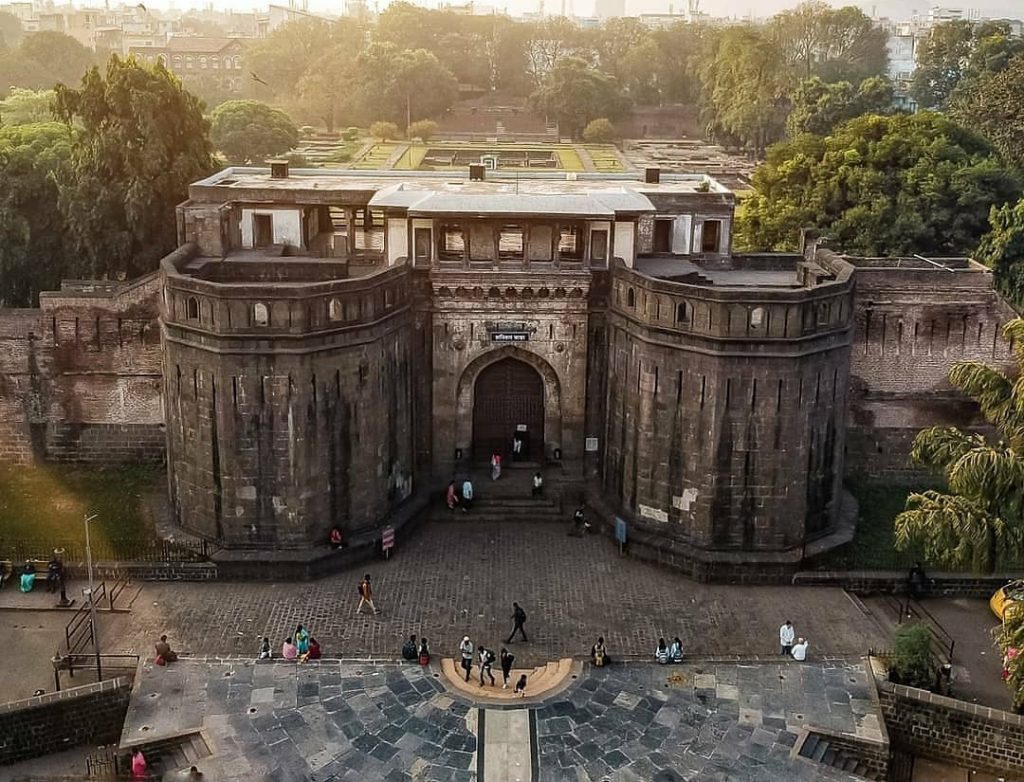We’ve all grown up learning about the pyramids of Giza, the largest Egyptian pyramid complex. The pyramids of Giza were built as royal tombs for three different pharaohs. This fascinating information has been a staple of our school curriculum, familiarising us with the grandeur of the pyramids and the mystery of mummies. However, there’s a place in India reminiscent of the pyramids of Giza, negating the need for a passport to witness such marvels – Charaideo Maidams of Ahoms.
In Assam, there are royal burial mounds commonly referred to as the ‘Pyramids of Assam.’ The architecture of these tombs, housing about 42 tombs of kings and queens atop a hill, mirrors the grandeur of the Egyptian pyramids and showcases the exemplary craftsmanship of medieval Assamese masons. These tombs are remnants of one of India’s most iconic yet forgotten empires, seldom mentioned in our schoolbooks.
Intrigued by this historical enigma, our team at Savaari decided to explore this site firsthand. We booked a taxi from Jorhat to Sivasagar to trace the rich history of this influential yet overlooked empire, which instigated revolutions, enacted significant changes, and played a pivotal role in shaping Indian history, all while being migrants. This is the Ahom Dynasty, an empire that mysteriously vanished after 600 years of rule.
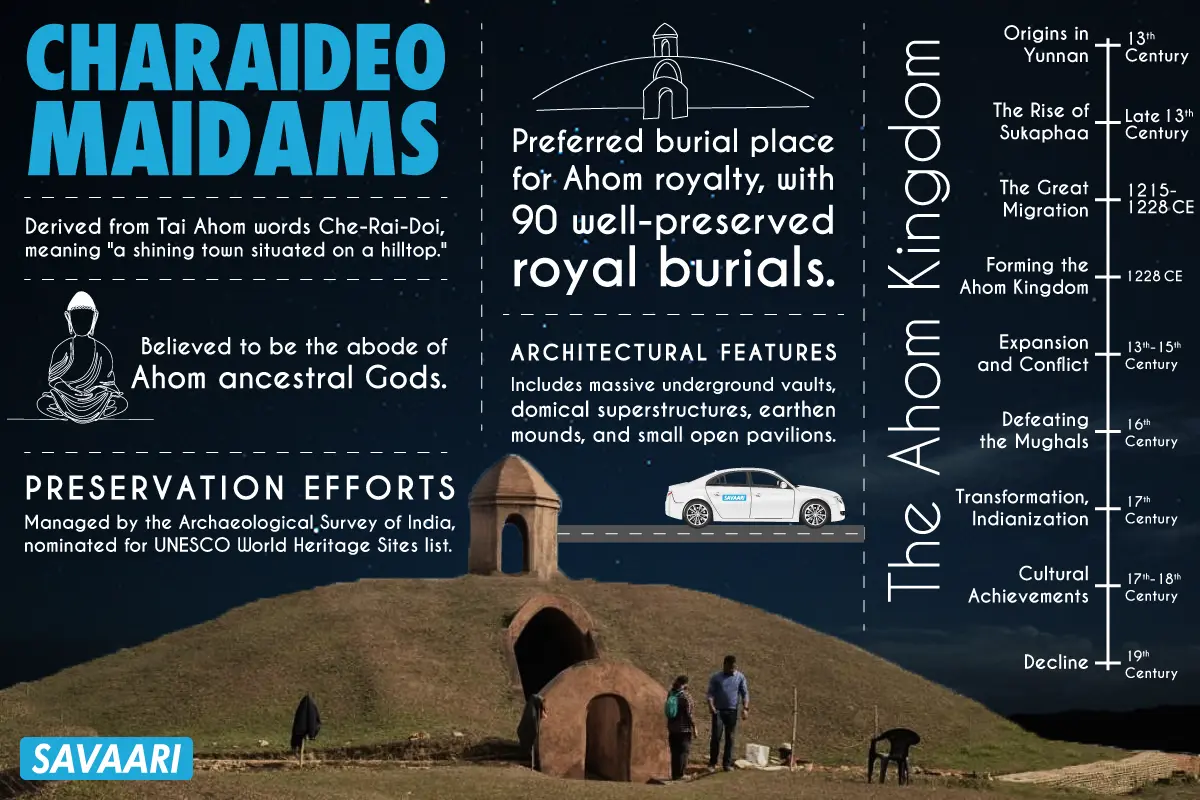
Tracing the route of the forgotten dynasty of Assam
Our journey from Jorhat began early at 6:15 am. With a two-hour drive ahead and numerous potential stops along the way, travelling in a Savaari cab was our faithful mount. Our chauffeur, well-versed in local knowledge, made the trip even more enjoyable. On this misty morning, everything felt just right.
As we set off for Charaideo Maidams, our chauffeur Biswas treated us to some of Assam’s finest tea. After all, tea is a must, when in Assam! Known for its expansive tea gardens, Assam offers a tea experience that is not to be missed. If you’re interested in exploring these tea gardens, click here for the perfect Assam tea garden road trip itinerary. Alongside this exquisite tea, we enjoyed coconut laddus and til peetha (sesame rolls with sticky rice and jaggery) – a healthy and delightful start to our journey. We were all set and excited, anticipating many discoveries.
As we chatted with Biswas, a veritable human encyclopedia, we were eager to learn about the Ahom dynasty. During the drive, our curiosity about this beautiful burial ground grew. To fully appreciate the significance of our destination, it’s crucial to understand the history of the Ahom Dynasty and the timeline of events that shaped its impactful legacy.
The Ahom Kingdom – How Tai migrants built a Northeast Indian superpower
The story of the Ahom Kingdom begins not in India but in the wealthy frontier region of Yunnan, China. In the 13th century, Yunnan was a bustling trade hub at the crossroads of overland routes connecting India, Tibet, Southeast Asia, and China. The Ahom, an ethnic Tai group, thrived in this environment under the prosperous Kingdom of Wong Mao. However, the relentless aggression of the Mongol Empire disrupted trade routes and destabilised the region, setting the stage for a dramatic change.
The rise of Sukaphaa
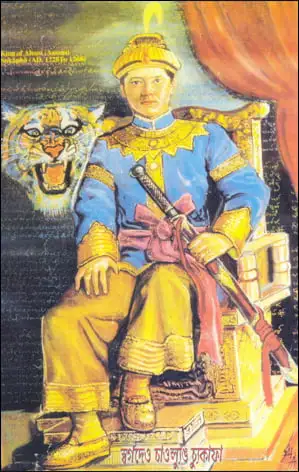
In the midst of 13th-century chaos, the Crown Prince of Muang Mao, Sukaphaa, was passed over for the throne. King Poong’s unexpected male heir displaced Sukaphaa, leading him to seek fortune elsewhere. Guided by his grandmother’s wisdom, Sukaphaa decided to carve out a new destiny in a different land. Hearing of the power vacuum in the Brahmaputra Valley of Northeast India, Sukaphaa seized the opportunity and set his sights on this fertile, strategically located region.
The great migration
Sukaphaa’s vision required a dedicated following, and he secured the allegiance of five Ahom lords, who brought warriors, priests, merchants, and peasants—totalling over nine thousand migrants. In 1215 CE, they embarked on a gruelling 13-year journey through Burma, employing diplomacy and, at times, force to secure safe passage. By 1227 CE, they had subdued tribes at Nanyang Lake and established subordinate states, creating a network of Mongs to support their advance.
Establishing the Ahom kingdom
After crossing the Patkai Mountains in 1228 CE, Sukaphaa and his followers entered the Brahmaputra Valley and founded their kingdom. The region, rich in resources, was home to powerful tribal polities who viewed the Ahom with suspicion. Through strategic marriages and alliances, Sukaphaa secured the support of the Barahi and Maran tribes, establishing a foothold and converting forests and marshes into thriving agricultural lands.
Expansion and Conflict
For the next two centuries, the Ahom engaged in intermittent conflicts with local Naga tribes. The Ahom’s superior military tactics, including the use of war elephants, gradually gave them the upper hand. Concurrently, they expanded their territory and integrated various ethnic groups through a process called “ahomization,” which involved political alliances, intermarriage, and sociocultural exchange.
Transformation and Indianization
Ahom religion is primarily based on worshipping Deities called Phi and Dam (Ancestor Spirit). Ancestor worship and the animistic concept of khwan are two elements it shares with other Tai folk religions. The 16th century marked a significant expansion for the Ahom, including the conquest of the Shutya Kingdom in 1523 CE. This brought millions of Sanskritized Hindus under Ahom rule, necessitating cultural integration. The Ahom began adopting Hindu practices and names, and during King Susungpa’s reign in the early 17th century, Hinduism became the state religion. Assamese gradually replaced the Ahom language in the court.
Administrative and cultural achievements
The Ahom kingdom developed unique institutions reflective of their Southeast Asian heritage. The Peg or Kell system of labour, which rotated groups of men through various work assignments, provided a stable workforce and promoted social cohesion. The Ahom constructed fortified cities, palaces, temples, and reservoirs, showcasing their architectural prowess and commitment to infrastructure.
Defeating the Mughals
The Ahom Kingdom was the last northeastern stronghold to face Mughal imperialism. Unauthorized trade by the Mughals in Ahom territories sparked the first Ahom-Mughal conflict in 1615-16. Initially, the Mughals, led by Abu Bakr, forced the Ahoms to retreat. However, at the Battle of Samdhara in 1616, the Ahoms launched a surprise attack, routing the Mughals and capturing their entire naval fleet. This victory thwarted the Mughal’s initial expansion efforts. Despite continued conflicts over trade and territory, the Ahoms consistently repelled Mughal advances, eventually extending their influence up to the Manas River by the end of the 17th century.
Decline and legacy
By the early 19th century, internal strife and external pressures weakened the Ahom kingdom. The British annexation of Assam in 1826 marked the end of the Ahom dynasty. Despite their fall, the Ahom left a lasting legacy through their administrative systems, architectural achievements, and the cultural integration of diverse groups.
Unlocking the secrets of Charaideo Maidams
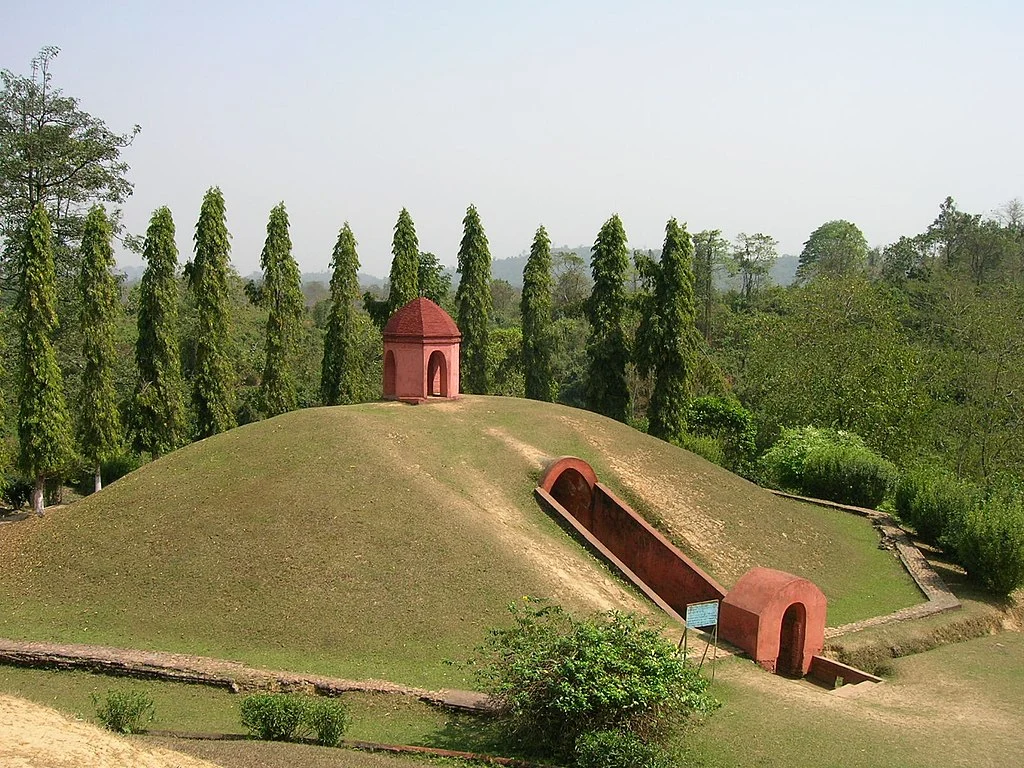
After travelling for 2 hours, we finally reached our destination. Stepping out of the cab, we were immediately captivated by the mystical allure of the Charaideo Maidams. The verdant mound rose majestically from the earth, crowned with an elegant brick structure. Towering evergreens flanked the site, their whispering leaves adding an air of reverence and mystery to the scene.
As we approached the red-bricked entrance, it felt like we were about to unlock the secrets of a bygone era. Biswas, our ever-informative chauffeur, shared intriguing insights about this place, telling us that the madams enshrine the mortal remains of Ahom royalty. These tombs hold not just the kings and queens, but also the paraphernalia they needed for the afterlife, including servants, horses, livestock, and even their wives. This ancient tradition speaks volumes about the Ahom Dynasty’s beliefs and the grandeur of their royal burials.
The symbolism of Charaideo Maidams
As we wandered through the site, Biswas explained that the word Charaideo is derived from three Tai Ahom words: Che-Rai-Doi. “Che” means city or town, “Rai” means “to shine,” and “Doi” means hill. In short, Charaideo means “a shining town situated on a hilltop.”
Biswas elaborated on how the Ahoms preferred to place their departed family members at Charaideo, where the first king, Sukaphaa, was laid to rest. After the 18th century, the Ahom rulers adopted the Hindu method of cremation and began entombing the cremated bones and ashes in a Maidam at Charaideo. Out of 386 Maidams or Moidams explored so far, 90 royal burials at Charaideo are the best preserved, representative of and the most complete examples of the mound burial tradition of the Ahoms. Charaideo is also believed to be the place of the ancestral Gods of the Ahoms, the abode of God Lankuri, identified with Lord Shiva.
Architectural marvels
Biswas pointed out that the maidam comprises a massive underground vault with one or more chambers having a domical superstructure. It is covered by a heap of earthen mounds and externally it appears as a hemispherical mound. At the top of the mound, a small open pavilion, or chow-chali, is provided. An octagonal dwarf wall encloses the maidam, and the height of a maidam is typically indicative of the power and stature of the person buried inside.
Preservation and management
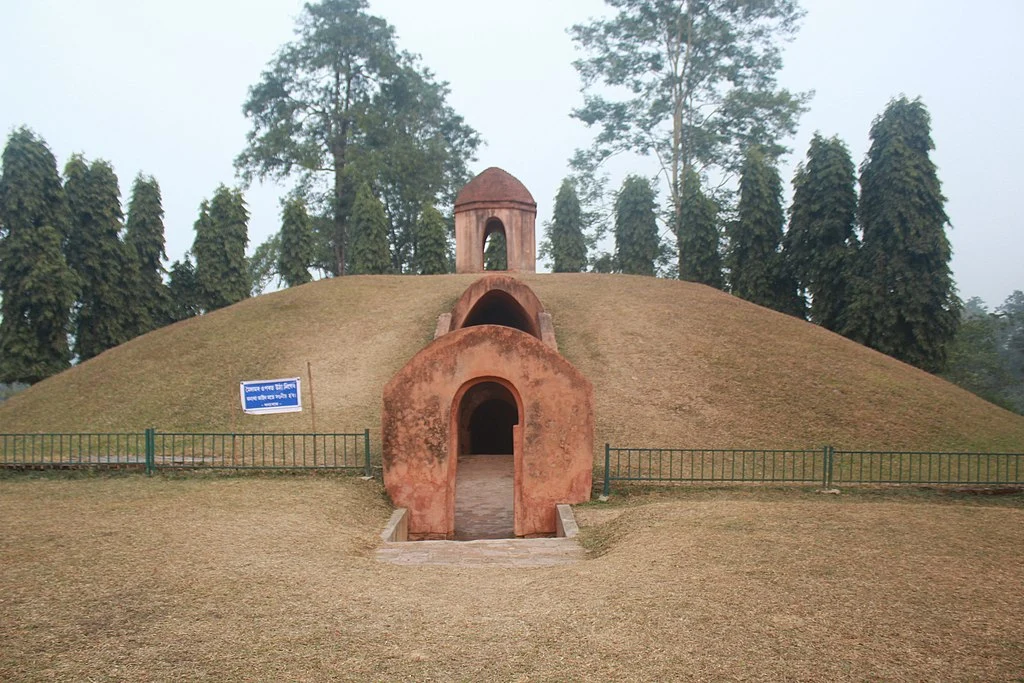
While exploring the site, we learned that there is currently no World Heritage Site in the category of cultural heritage in the northeast. The maidams are one of the 52 sites across the country seeking the World Heritage Site tag. Currently, the Maidams are managed by the Archaeological Survey of India and the State Department of Archaeology under the Ancient Monuments and Sites Remains Act 1958, and under the Assam Ancient Monuments and Records Act 1959.
The Centre has decided to nominate Assam’s Charaideo Maidams — the Ahom equivalent of the ancient Egyptian pyramids — for the UNESCO World Heritage Sites list this year. The nomination of the Charaideo Maidams has attained significance at a time when the country is celebrating the 400th birth anniversary of Lachit Barphukan, the legendary general from the Ahom Kingdom who fought the Mughals in 1671.
The Charaideo Maidams stand as silent sentinels of a bygone era, encapsulating the glory and grandeur of the Ahom Dynasty. These royal tombs not only reflect the architectural brilliance of medieval Assam but also narrate the tale of a dynasty that shaped the region’s history and culture. As we stood amidst the majestic mounds, it was evident that the Ahoms’ legacy continues to resonate, urging us to delve deeper into the annals of India’s rich and diverse history.
The life of Ahom people today
During our journey, we had the pleasure of meeting Ai Seng, a man from the Ahom tribe, who shared insights into his community’s current status. Today, the Ahom tribe is categorized under the Other Backward Classes (OBC) caste category. Ai Seng explained the longstanding discussions and demands for Scheduled Tribe status. He also mentioned that the term “ethnic Assamese” is now associated by the Indian government with various indigenous Assamese people. According to Anthony Van Nostrand Diller, possibly eight million speakers of Assamese can claim genetic descent from the Ahoms.
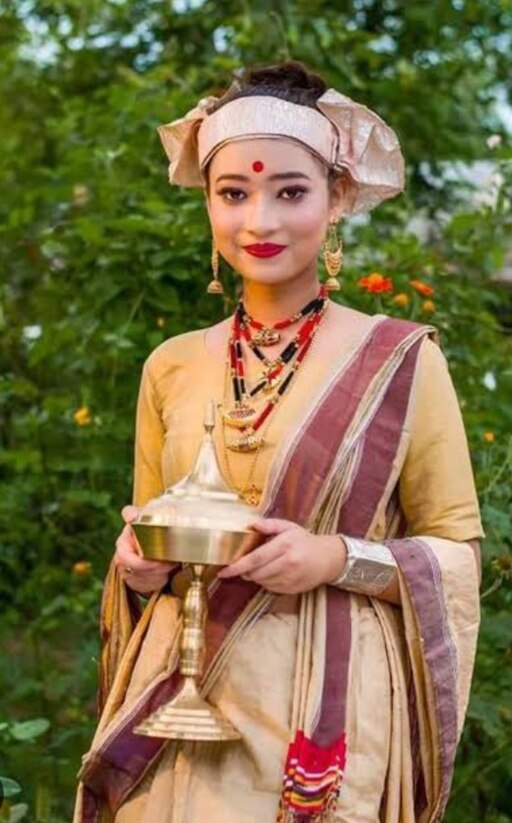
Language revival and cultural resurgence
Ai Seng informed us that the Ahom tribe now primarily uses the Assamese language, as their traditional Ahom language has fallen into complete disuse. The Ahom language, a member of the Tai branch of the Kra–Dai languages, is now extinct, with its tone system completely lost. However, some Tai Ahom organizations are working to revive it. From the late 20th century through the early 21st century, there has been a resurgence of interest among the Ahoms in their culture and language, leading to increased scholarly focus and revival efforts.
Traditional lifestyle and architecture
We learned from Ai Seng that the traditional lifestyle of rural Ahom families resembles that of the rural Thai people of Thailand. Their houses are typically made of wood and bamboo with thatched roofs. The families’ orchards and ploughed fields are situated near their homes, which are built in a scattered fashion within bamboo groves. This is quite similar to the Apatani tribe’s system of agriculture, which you can read all about here. Historically, Ahom houses were built on stilts called Rwan Huan, about two meters above ground level.
Cuisine and food culture
Food plays a crucial role in Tai-Ahom culture, Ai Seng shared. Most Ahoms, particularly in rural areas, are non-vegetarian, maintaining a traditional cuisine similar to other Tai people. Rice is a staple food. Typical dishes include pork, chicken, duck, slices of beef, frogs, various kinds of fish, hukoti maas (dry preserved fish mixture), muga lota (cocoon seeds of endi and muga worms), and red ant eggs. Certain insects are also popular foods for the Ahoms. Traditional drinks include Luk-Lao or Nam-Lao (rice beer). The Ahoms consume “Khar” (alkaline liquid extracted from burned banana peels/bark), “Betgaaj” (tender cane shoots), and many naturally grown herbs with medicinal properties.
However, beef is avoided by general Hindus and pork by Vaishnavites. Ahom food specialities resemble Thai cuisine, preferring boiled food with little spices and directly burnt fish, meat, and vegetables. Some popular dishes are Thu-dam (black lentil), Khao-Moon (Rice Frumenty), Xandohguri (a powder made from dry roasted rice), Chewa Khao (steamed rice), Chunga Chaul (sticky rice cooked in tender bamboo tubes), Til pitha (sesame rice rolls), and Khao-tyek (rice flakes). Unique preparation methods for these items were unknown to others outside the Ahom and Thai communities.
Religion and beliefs
Ai Seng also told us about the religious practices of the Ahom tribe. The majority of present-day Ahoms profess Hinduism, yet there is a movement aiming to rejuvenate the ancient Ahom faith. The decline of the Ahom religion began during the reign of Jayadhwaj Singha, the first Ahom king to adopt Ekasarana Dharma and take initiation from the Auniati Mahanta. From Jayadhawaj Singha to Rantadhwaj Singha, all Ahom kings followed Ekasarana Dharma. From Gadadhar Singha onwards, the kings leaned towards Shaktism, with Siva Singha making Shaktism the state religion.
Suremphaa Rajeswar Singha ordered Sanskritisation, and all funerals were conducted under Hindu cremation rites, led by a Maithil Brahmin priest alongside a traditional priest. Despite these changes, the festival of Me-Dam-Me-Phi is widely celebrated, reflecting the enduring cultural heritage of the Ahom tribe.
From Charaideo to Sivasagar – The majestic monuments of the Ahom Kings
Charaideo Maidams is not the only place where you can witness the remnants of the great Ahom Dynasty. The footprints of this illustrious empire are scattered near the present-day town of Sivasagar, which once served as their capital. Over the years, the Ahoms integrated with the local population, embracing and amalgamating their customs and traditions into their own. The architectural monuments of Sivasagar can be divided into two categories: religious temples, known as “Dol,” and secular structures like palaces, tanks, and maidams. Sivasagar, the land of temples in Assam, offers a cradle to understand the history of the Ahom Kings who significantly shaped Assamese tradition and legacy. Our team, with the help of our knowledgeable chauffeur Biswas, explored these historic locations.
Talatal Ghar
Our first stop was Talatal Ghar, one of the must-visit monuments in Sivasagar. This erstwhile palace features a seven-storeyed structure, with three floors below ground and four above. We learned from Biswas about the secret tunnels rumoured to exist here, adding an air of mystery to the site. The palace, built by Ahom King Rudra Sinha, was constructed using thin bricks, with eggshells and rice paste used as mortar in the absence of lime. Presently, only the first and one of the underground floors are accessible, while the others have deteriorated. Despite its seemingly disorganized layout, the palace’s symmetry becomes apparent upon spending time in its sprawling grounds.
Kareng Palace
Next, we visited Kareng Palace, situated about 13 km from Sivasagar. This palace marked the Ahoms’ shift of their capital from Charaideo Maidams. Originally built from wood, stone, and bamboo, the palace featured intricate woodwork and motifs. Biswas explained that, unfortunately, the palace has not withstood the test of time, and today, only a single portion remains. The building, resembling a chariot tapering off into a narrow structure at the top, is five stories high with one floor below ground. We explored each floor, marvelling at the architectural ingenuity of the Ahoms.
Rang Ghar
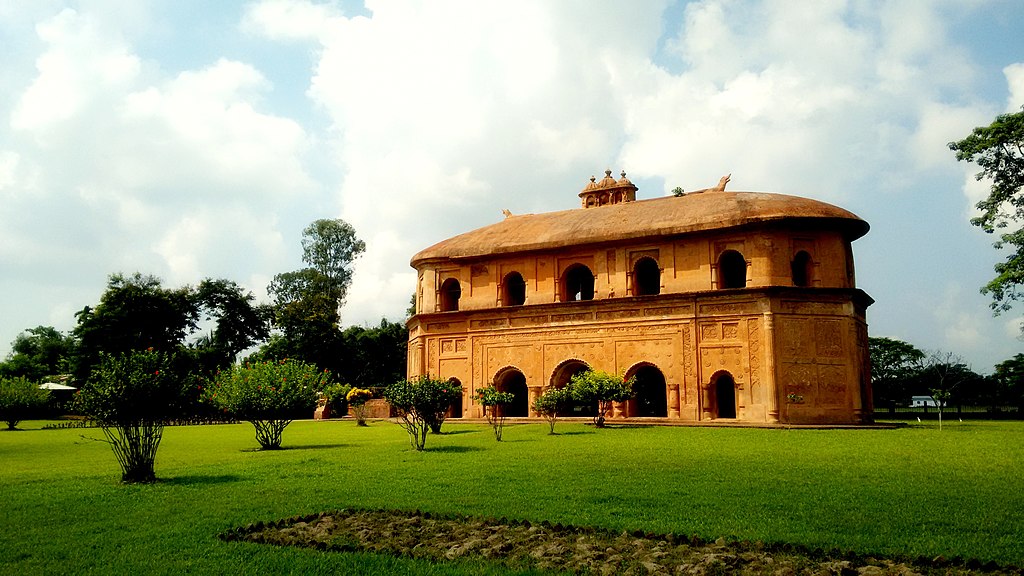
Rang Ghar, built in 1746, was our next destination. This pavilion and amphitheatre were designed for the royal family to enjoy sports and indoor games. Constructed in the shape of an inverted boat, the double-storied building features walls decorated with panels depicting animal fights, though little remains today. Climbing to the first floor, we could still see some decorative motifs. The beautifully landscaped grounds, adorned with sculptures placed by the Archaeological Survey of India (ASI), added to the site’s charm.
Sivasagar Lake
Adjacent to the main temple of Shiva Dol lies the vast and hauntingly beautiful Sivasagar Lake. Built by Ahom Queen Ambika in 1734, the artificial lake ensured a steady water supply. The lake is a constant source of delight and serenity for the residents of Sivasagar. We took a leisurely walk along its edge, enjoying a cup of tea and reflecting on our journey. The presence of large trees along the lake’s perimeter adds to the peaceful vibes, making it a perfect spot for contemplation.
Ahom Museum
Our exploration continued to the Ahom Museum, founded post-independence and opened to the public in 1972. Located on the banks of Sivasagar Lake, the museum is surrounded by swaying trees, creating an inviting atmosphere. The museum houses one of the largest collections of jewellery, artefacts, and art related to the Ahom dynasty. Major attractions include ancient manuscripts, metalworks, weapons, and traditional attires. Biswas highlighted that the museum showcases the history, art, culture, and daily lives of the Ahom people, with some artefacts dating back to King Sukaphaa’s invasion in 1222.
Shiva Dol
Our final destination was Shiva Dol, a temple dedicated to Lord Shiva, reputed to be one of the tallest in the world at 180 feet. Built-in 1734 by Ahom Queen Ambika, the temple draws enormous crowds even today. Situated on the banks of Sivasagar Lake, it is flanked by two other temples, Vishnu Dol and Devi Dol. These temples are a must-visit for anyone coming to this part of Assam.
How to go on a road trip to these Ahom destinations from Guwahati
This itinerary was created for one of our Savaari customers, Indumati, during her trip to Assam. She booked a Savaari from Guwahati and explored various Ahom empire locations in Jorhat, Sivasagar and Charaideo Maidams. Start your road trip early from Guwahati, preferably around 6 am, and head towards Jorhat. The journey covers approximately 303 km.
1. Nimati
Your first stop can be Nimati, a historical river port dating back to the Ahom kingdom and the British colonial era. It played a vital role in trade and transportation and is now known for its picturesque landscape and views of the Brahmaputra River.
2. Lachit Borphukan’s Maidam
Proceed to Lachit Borphukan’s Maidam, a historical monument and burial site dedicated to the memory of Lachit Borphukan, an iconic Ahom general who played a crucial role in the Battle of Saraighat. This site serves as a reminder of the bravery and military prowess of Lachit Borphukan and the Ahom warriors.
3. Bangalpukhari
Stop by Bangalpukhari, a historic tank dating back to the Ahom dynasty.
4. Burigosain Devalay
Visit Burigosain Devalay, also known as Buri Gussain temple, located in Jorhat. It is believed to have been established in the 18th century by Ahom King Rajeshwar Singha.
5. Ladai Garh
Explore Ladai Garh, an ancient fortress built by Ahom King Swargadeo Pratap Singha in the 17th century. Although the structure is now in ruins, it still holds immense historical significance and offers a glimpse into the architectural and military prowess of the Ahom dynasty.
6. Sukapha Samannay Kshetra
Head to Sukapha Samannay Kshetra, a memorial park and cultural centre dedicated to Chaolung Sukapha, the founder of the Ahom dynasty. Located on the outskirts of Jorhat, the park features a life-size statue of Sukapha, an amphitheatre, and beautifully landscaped gardens.
7. Raja Maidam
Visit Raja Maidam, a historical site housing the burial mounds of Ahom royalty, including the vaults of King Purandar Singha and his queen.
From Jorhat, proceed to Sivasagar to explore the aforementioned Ahom destinations, which take about two hours. From Sivasagar, it is just over an hour’s drive to Charaideo Maidams. Our customer Indumati used this itinerary and made the most out of her trip. She took over a day to explore these locations.
“My trip with Savaari was incredibly convenient and enjoyable. The driver was very cooperative and informative, providing valuable insights into the Ahom Dynasty history and the significance of each site. I never knew about it! It was a seamless and enriching experience, allowing me to fully appreciate the beauty and heritage of Assam. Even as I got back to Guwahati, I was sent this handy Guwahati travel guide, which helped me make the most out of my time there. I highly recommend taking a trip, especially if you’re a history buff like me!”
Indumati Verma
Discover the forgotten legacy of the Ahom dynasty with Savaari
As our trip came to an end, we were elated to have unearthed so much forgotten history. India is rich with hidden stories that deserve to be told, and this journey ignited our desire to delve deeper beyond the standard curriculum to rediscover forgotten empires that, though silent now, were once profoundly impactful.
The Ahom Dynasty, in particular, impressed us with its respectful integration and enhancement of the existing culture. Rather than destroying the local customs, they enriched and prospered alongside them. The spectacular architecture left us eager to explore even more. This trip offered us a fresh perspective on Assam, allowing us to truly appreciate the legacy of this powerful dynasty.
If you ever plan on visiting Assam, be sure to add the Charaideo Maidams to your itinerary. However, it’s disheartening to note that while 30 of these burial mounds are protected by the ASI, many others are in a state of decay due to human encroachment. We hope that Charaideo Maidams receives the UNESCO World Heritage Site tag it so rightly deserves. To experience the beauty of Assam and visit these historical sites, download the Savaari app. Travel on your own terms and enjoy Assam with the guidance of an expert chauffeur.
Last Updated on August 19, 2024 by Shabari Shankar



